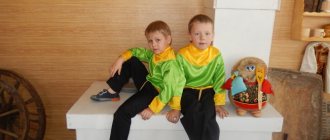“Just as there is no man without self-love, so
There is no man without love for the fatherland, and this love
gives education the sure key to a person’s heart..."
K.D.Ushinsky
Relevance of the project:
Currently, children have a poorly developed cognitive interest in the folk toy and its history, because store shelves are overflowing with a variety of foreign-made toys, and information systems actively advertise them. Parents practically do not buy traditional toys for modern children. The centuries-old experience of mankind has shown the importance of introducing children to the culture of their people, since turning to the paternal heritage fosters respect and pride for the land on which you live. Therefore, children need to know and study the culture and traditions of their ancestors. If a child is not introduced to folk arts and crafts in preschool childhood, then full familiarization with the history and culture of his people will not be achieved, which will subsequently lead to the impoverishment of his moral and patriotic feelings. It should be noted the role of folk toys in the process of teaching preschoolers almost all types of children's activities.
Project goal: Introducing children to folk culture through familiarization with folk toys .
Project objectives:
- To arouse a desire in children to get acquainted with the variety of folk toys (clay, wood, rag, straw, birch bark, etc.)
- Ensure memorization of games with folk toys, the possibility of using them in various types of children's activities (moving, plot, director's games, theatrical activities, visual arts based on folk toys)
- To promote the development of cognitive interests, aesthetic perception, logical thinking, attention, imagination, sensorimotor skills, dexterity, ingenuity.
- Form and develop communication skills, the desire to use folk toys in joint and independent activities.
Project type:
By the nature of the subject area: Socialization
Composition : group
By average duration (03/20/13-03/31/13)
The participants of the project are middle preschoolers, teachers of the institution, and parents.
Estimated results of the project:
- Knowledge of various types of folk toys and the content of games with them
- The ability to organize joint and independent play activities with folk toys
- A persistent desire to play with a traditional toy
Form of the final event: Evening of entertainment “Visiting grandma - Zabavushki”
Intended product of the project: Exhibition of creative works of children.
Project implementation scheme
| STAGE | Integration of educational areas | Joint activities of adults and children, taking into account educational areas | Developmental environment | Working with parents |
| preparatory | Survey of children (Appendix) Conversation about the lives of children in the past, their activities, games, toys. Conversation about the work of adults creating objects of decorative and applied art. Examination of illustrations about the life of children in the past. | Selection of Russian folk tales Selection of didactic games Albums “Folk Toy”, illustrations about decorative and applied arts. Articles on the topic “Where did the first toys appear in Rus'”, “All about folk toys”, | Joint holidays “Holidays of the national calendar” (Maslenitsa) Visual propaganda, mobile folders. | |
| basic | Conversations “Why do we need toys?” “Who makes them?” “How should you handle toys?” Experiments-comparisons of wooden, clay and hair toys (Heavy - light, cold - warm) GCD “Visiting the Magpie” Theatrical game “Turnip from a nesting doll” Riddles about folk crafts Learning rhymes, poems, proverbs, fables, D. game “House for nesting dolls” (correlation by size; with design elements) “Which doll is hidden?” “Describe the toy” “Arrange the nesting dolls by size” Finger games “Matryoshka”, “Dymkovo ladies” Physical education minutes Breathing exercises “Admiring the toys, Ducky, Blowing, Blowing” Russian folk outdoor games “Rasteryakhi”, “Lark”, “Dudar”, “Geese-geese”, “Golden Gate”. Role-playing game “Toy Store”, “Let’s Go to the Museum” Develop skills in safe handling of scissors. Cultivate a caring attitude towards things. Expand your understanding of how to safely handle clay and porcelain toys. Let's put things in order on the shelves. Fostering a positive attitude towards work. Drawing GCD “Dymkovo Horse” Application “Let’s Decorate the Matryoshka Dolls” Construction “Toy Store” Learning ditties Round dance game “The lark sang in the sky” Dance “We are nesting dolls” Orchestra of folk toys | Examination of Illustrations of a variety of folk toys Illustrations in books Exhibition of folk toys | Consultation for parents “The role of folk games and toys in the education of preschool children” Information and poster materials “How to sculpt a whistle” “How to make a doll” | |
| final | Evening of entertainment “Visiting grandma - Zabavushki” Goal: Introducing children to the origins of Russian folk culture. Exhibition of children's creative works. | Parents are involved in preparing the entertainment. |
Conclusion: The project achieved its goals and objectives. Many warm words were said about the project by parents. They noted that the children learned a lot of interesting things about folk crafts, gained experience playing with folk toys,
using them in independent activities,
they began to share their impressions with family and friends. They have a desire to independently acquire knowledge; children actively engage in communication and are able to defend their point of view.
APPLICATION.
Survey of children
18 children took part.
Do you know how to play with it?
Conclusion: Analyzing the results obtained, we can conclude that most children have no idea what toys they played with before. And 28% of children have no idea how and what they can play with a folk toy.
Survey of children
18 children took part
Conclusion: At the beginning of the study, a lack of knowledge among children about the history of folk toys was revealed; in addition, many of the children had no idea how and what to play with folk toys. However, after a short story about the toys that were played in the old days, and the play activities held, the preschoolers still became interested in this issue, learned a lot of new things for themselves, helped prepare play material, and passed on the information to others.
MAGAZINE Preschooler.RF
Educational project "RUSSIAN FOLK TOY" Middle groupHello, I would like to publish my project dedicated to Russian folk toys.
It all started when I came across a book about a Russian folk rag doll. I wanted to tell the guys about these wonderful dolls. But if we talk about dolls, then we need to talk about other folk toys. The result was a whole project: we painted; sculpted; played with Russian folk toys; learned nursery rhymes, fables, lullabies; staged them; played Russian folk games; made a Pelenashka doll with our own hands. Our parents also helped us. They participated in the family living room, in organizing the exhibition “Toys of Our Grandmothers” . I have attached the text of the project and a photo to it to the letter.
Sincerely, Olga Sergeevna Astakhova, teacher, GBOU School No. 947 Moscow 2015
Project Description
Relevance of the project:
A modern child is focused on toys from Western countries and does not have sufficient information about traditional folk toys. Therefore, given the importance of toys for both children and adults, it is necessary to introduce children to folk toys, which will help to introduce them in the future to the national culture of Russia. The relevance of the project lies in the return of the younger generation to Russian national traditions, to the study of historical roots.
Our project will allow:
- to generate interest in folk toys, folk arts and crafts, master the art of making toys with your own hands, elements of painting;
- instill respect for Russian history;
- replenish the subject development environment;
- put a piece of your soul into a toy, become masters.
Project goal: To introduce children to folk culture through familiarization with folk toys.
Project objectives:
- Introduce children to the variety of folk toys (clay, wood, rag, straw, etc.), with the characteristic features of different crafts.
- To form an aesthetic attitude towards objects of art, to teach them to see their beauty and originality.
- Instill respect for the culture of your people.
- To develop communication skills in children: communication and interaction with adults and peers, emotional responsiveness, empathy, and a friendly attitude towards others.
- Enrich children's vocabulary, introduce new words and their meanings.
- Create a desire to create something beautiful with your own hands.
- To foster a value-based attitude towards family traditions and the joint work of adults and children.
Project type:
Composition: group
Duration: medium-term (1 month)
The participants of the project are middle preschoolers, teachers of the institution, and parents.
Nature of the subject area: cognitive development
Integration of areas: cognitive development, social and communicative development, artistic and aesthetic development, speech development, physical development.
Project implementation stages:
- 1. Preparatory
- 2. Main
- 3. Final
Estimated outcome of the project:
- nurturing a love for Russian folk art
- a child is a creator, master, creator of a folk toy
- the child knows how to collaborate in a team
The expected product of the project: dolls made by hand, an open lesson “Visiting the hostess” .
Project implementation scheme
Preparatory stage
- Setting goals, determining the relevance and significance of the project.
- Selection of methodological literature for the implementation of the project (magazines, articles, abstracts, etc.).
- Selection of visual and didactic material; fiction; didactic games, development of conversations, development of activities
- Development of consultation for parents.
- Organization of a developmental environment in a group
| Next > |





